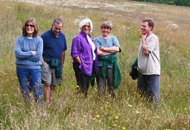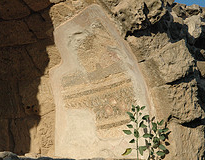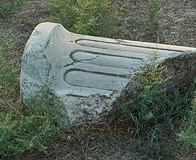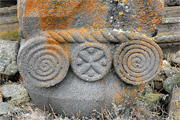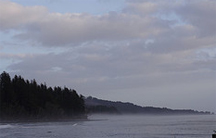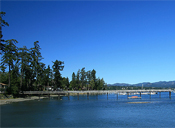Le Caprice
 Le Caprice Restaurant is in my opinion the best place in London, and one of the best in the world, to dine at the bar—alone, if you are, or with someone special. It's an intimate two-person venue—not suited to more, as the linear seating makes conversation among more somewhat awkward. It is, however, very usual to strike up a conversation with someone on either side of the two of you, and it might be anything from a barrister out of a tough courtroom, to a (perhaps) Italian count, or a fellow countryman.
Le Caprice Restaurant is in my opinion the best place in London, and one of the best in the world, to dine at the bar—alone, if you are, or with someone special. It's an intimate two-person venue—not suited to more, as the linear seating makes conversation among more somewhat awkward. It is, however, very usual to strike up a conversation with someone on either side of the two of you, and it might be anything from a barrister out of a tough courtroom, to a (perhaps) Italian count, or a fellow countryman.
Around the corner from The Ritz and at the end of an elegant cul de sac, the restaurant is an understated symphony in black and white—floor tiles, wall photos, seating. The bowler-hatted doorman whisks you out of your cab, momentarily through the frigid air and into the warm, welcoming bar, where a pianist at the side plays jazz and standards to add a note of elegance. The room buzzes with glamorous decked-out women and well-dressed men (for the most part). A tie is not required, but even in my modern casual mode, I'd never go without a black sports coat.
 The food at Caprice is perfectly suited to sharing, one course at a time, along with samplings of wine. On a recent visit we started with the Dressed Dorset crab with celeriac Rémoulade—a menu icon, impecably fresh and tasting of the sea. Next we shared sauted field mushrooms topped with a poached egg and crispy cured ham—deep and earthy. Wood pidgeon on toast was rich and gamey as a seasonal special. Another Caprice icon is the Steak Tartare—perfectly spiced knife-cut steak which still retains its beefiness below the spices. For something sweet we couldn't resist the honeycomb ice cream with warm chocolate sauce—a perfect ending. While we rarely take them, main courses include seasonal duck, roast pork belly, traditional calves liver with bacon and onions, and whatever fish the market brings. If you want the ultimately in simplicity, you can order the battered haddock and chips, or eggs Benedict with hash browns.
The food at Caprice is perfectly suited to sharing, one course at a time, along with samplings of wine. On a recent visit we started with the Dressed Dorset crab with celeriac Rémoulade—a menu icon, impecably fresh and tasting of the sea. Next we shared sauted field mushrooms topped with a poached egg and crispy cured ham—deep and earthy. Wood pidgeon on toast was rich and gamey as a seasonal special. Another Caprice icon is the Steak Tartare—perfectly spiced knife-cut steak which still retains its beefiness below the spices. For something sweet we couldn't resist the honeycomb ice cream with warm chocolate sauce—a perfect ending. While we rarely take them, main courses include seasonal duck, roast pork belly, traditional calves liver with bacon and onions, and whatever fish the market brings. If you want the ultimately in simplicity, you can order the battered haddock and chips, or eggs Benedict with hash browns.
Whatever your taste buds feel like, you'll likely be able to compose a menu to suit, and you'll be made to feel like a regular by the friendly and attentive staff. And if you're one, or two--do dine at the bar.
Caprice WILL take advance reservations for seats at the bar, and they're recommended, due to its popularity. Dinner with wine around $100 per person.
Le Caprice, Arlington Street, London SW1
Tel (02076292239)
http://www.le-caprice.co.uk/
Greens Restaurant & Oyster Bar
 Another London classic for us, worthy of a visit every trip, is Greens in St James. We always order the same things (save perhaps dessert). The freshest channel oysters for one, quails egg's with mayonnaise for the other--accompanied by glasses of Champagne--perhaps the Widow, perhaps Le Mesnil, perhaps Billecart-Salmon Rose. Then grilled Dover sole, on the bone, with beurre blanc, and whatever vegetables and potatoes are seasonal accompanied by a bottle of white burgundy--nothing over the top, but perhaps a Saint-Véran Domaine de la Croix Senaillet or Rully Blanc Domaine Dureuil-Janthial. An ethereal combination--no better fish in the world and one of the best settings in which to have it.
Another London classic for us, worthy of a visit every trip, is Greens in St James. We always order the same things (save perhaps dessert). The freshest channel oysters for one, quails egg's with mayonnaise for the other--accompanied by glasses of Champagne--perhaps the Widow, perhaps Le Mesnil, perhaps Billecart-Salmon Rose. Then grilled Dover sole, on the bone, with beurre blanc, and whatever vegetables and potatoes are seasonal accompanied by a bottle of white burgundy--nothing over the top, but perhaps a Saint-Véran Domaine de la Croix Senaillet or Rully Blanc Domaine Dureuil-Janthial. An ethereal combination--no better fish in the world and one of the best settings in which to have it.
Green's Restaurant & Oyster Bar
36 Duke Street St. James's
London SW1Y 6DF
Tel: 020 7930 4566
http://www.greens.org.uk
 Sunday, March 22, 2009 at 01:16PM
Sunday, March 22, 2009 at 01:16PM 





